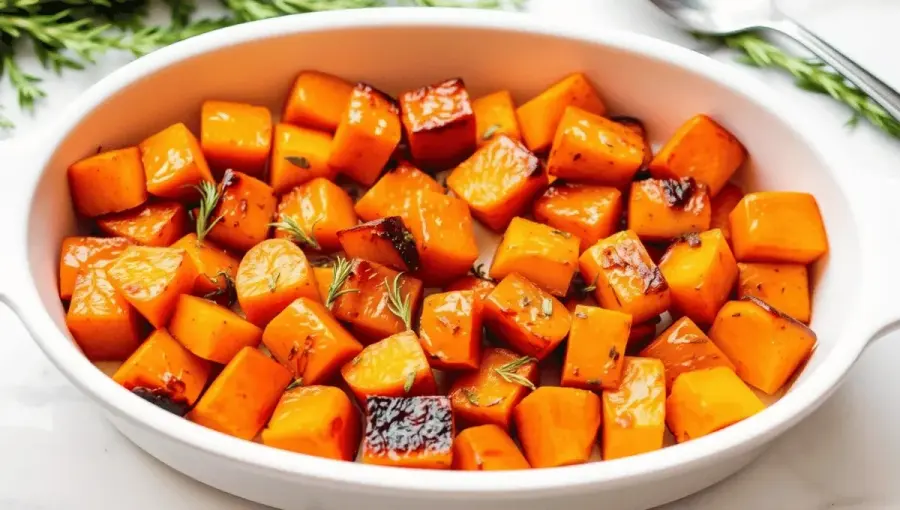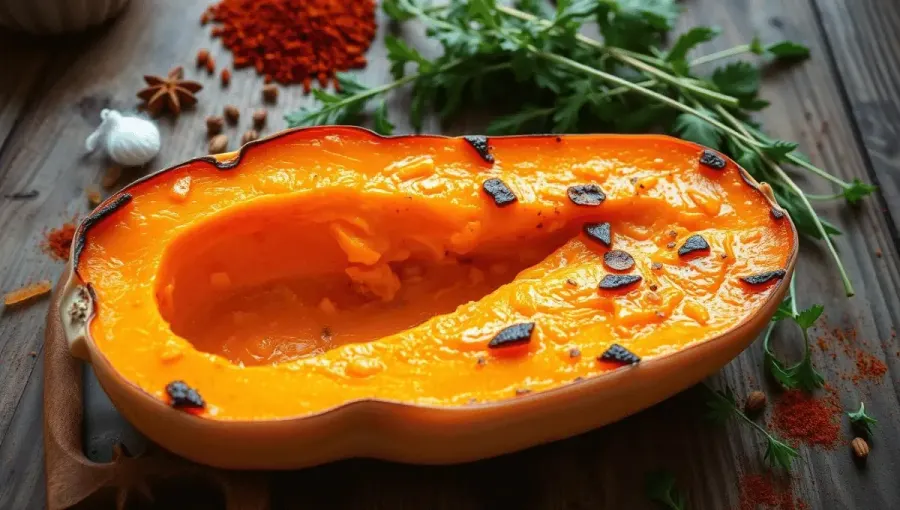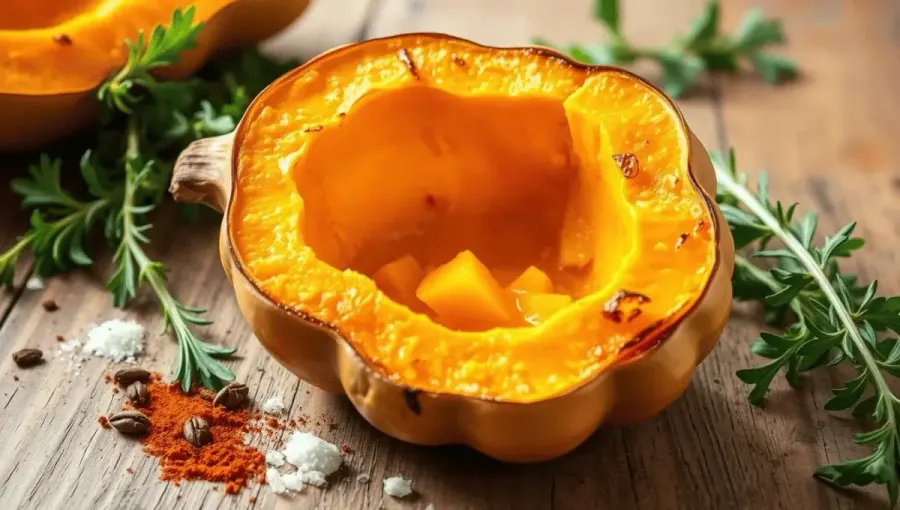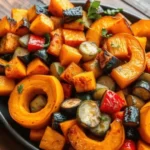
If you’re on the hunt for a side dish that’s equal parts delicious and easy, you’ve just found your new best friend: roasted butternut squash. Imagine this: golden, caramelized edges with a soft, melt-in-your-mouth interior—pure comfort food, without the guilt. Whether you’re looking to add a pop of color to your plate or want a healthy, satisfying side to pair with just about anything, this recipe has got you covered.
But wait—this isn’t just any roasted squash recipe! In this guide, we’ll walk you through everything you need to know—from how to peel and cut that tough squash (trust us, we’ve got tips that’ll save you time and frustration) to the best seasoning combos that’ll make your taste buds sing. Plus, we’ve sprinkled in expert tricks, storage tips, and serving suggestions to elevate this dish to the next level.
Stick with us—we promise you won’t regret it. Keep reading, because you’re about to become a roasted butternut squash pro!
Why Roast Butternut Squash?
Roasting butternut squash brings out its natural sweetness and enhances its flavor, creating crispy, caramelized edges while keeping the inside tender and creamy. It’s an incredibly easy cooking method that requires minimal prep and yields maximum flavor. Plus, roasting helps retain the squash’s nutrients, making it a healthy and satisfying addition to any meal.
What makes it so versatile is its ability to take on different flavor profiles. You can keep it simple with just olive oil, salt, and pepper for a minimalist approach, or amp up the flavor with spices like cinnamon, cumin, or smoked paprika. Want something even more adventurous? Toss it with herbs like rosemary or thyme, or add a drizzle of maple syrup for a sweet, fall-inspired dish. The possibilities are endless, which is exactly why it’s a perfect side for any meal, any time of year.
Table of Contents

What Makes This Recipe So Delicious?
So, why is this roasted butternut squash recipe so darn irresistible? It all comes down to the magic of roasting! When you pop that squash into the oven, the natural sugars in the flesh caramelize and turn into little bites of heaven, with crispy edges and a soft, velvety inside. It’s like the squash is giving itself a glow-up.
Here’s why this method works so well:
- Sweet & Savory Perfection: The roasting process brings out the natural sweetness of the squash, while the high heat creates those golden, crispy edges that we all crave. It’s a flavor party in every bite.
- Minimal Effort, Maximum Flavor: No need for complicated cooking techniques here! Just chop, season, and let the oven do its thing. The result? A side dish that practically cooks itself.
- Texture that Rocks: The outside gets beautifully caramelized, while the inside stays soft and creamy. It’s the perfect contrast of textures that makes each bite totally satisfying.
- Customizable to Your Taste: Want to go sweet? A sprinkle of cinnamon or a drizzle of maple syrup will do the trick. Prefer savory? Toss in some garlic and thyme. The flavor combinations are endless!
Ingredients for Roasted Butternut Squash
Ready to get roasting? Here’s what you’ll need to make this dish as delicious as possible—spoiler alert: it’s simple but packs a punch of flavor!
- 1 medium butternut squash – The star of the show! Sweet, nutty, and ready to roast.
- 2 tablespoons olive oil – For that golden, crispy finish. Plus, it helps all those flavors stick.
- Salt – Just a pinch (or a few) to bring out the squash’s natural sweetness.
- Freshly ground black pepper – A dash of this adds a little kick to balance out the sweetness.
Optional Spices & Flavor Boosters:
- Cinnamon or nutmeg – Perfect if you’re craving a cozy, fall-inspired twist.
- Garlic powder – A little savory punch never hurt anyone.
- Smoked paprika – If you’re feeling smoky and bold, this will add an amazing depth of flavor.
- Fresh thyme or rosemary – Fresh herbs take this dish to next-level deliciousness.
How to Prepare Butternut Squash for Roasting
Before we get to the fun part (aka roasting), we need to get that squash ready for its time in the oven. Don’t worry, we’ll guide you through the peeling and cutting process, and soon you’ll be a squash prep pro!
How to Peel Butternut Squash: Step-by-Step Guide
Peeling a butternut squash may sound intimidating, but with the right tools and a little confidence, you’ve got this!
- Grab a sharp vegetable peeler – Trust us, a good peeler is your best friend here.If you don’t have one, a good sharp knife will work just as well.
- Trim the ends – Cut off both the top and bottom of the squash to give yourself a flat base.
- Peel it away – Start at the top and work your way down, peeling off the skin in long strips. It’s tougher than it looks, but just keep going—you’re almost there!
- Optional shortcut – If you find the skin too stubborn, you can microwave the squash for 1-2 minutes to soften it up before peeling.
How to Cut Butternut Squash: The Most Effective Way to Slice or Cube for Even Roasting
Now that it’s peeled, let’s cut that squash into perfect pieces that will roast evenly and get those delicious caramelized edges.
- Cut the squash in half – Place the squash on a cutting board, and carefully cut it lengthwise from top to bottom. This will give you two pieces: the bulbous, seed-filled bottom and the long, narrow neck.
- Scoop out the seeds – Use a spoon to scoop out the seeds from the bottom half. (Don’t throw them away—roasted squash seeds are a tasty snack!)
- Cut into uniform pieces – For the neck, slice it into rounds or cut it into long strips, then cube it for even roasting. For the bottom half, cut into slices or chunks that are about 1-inch thick.
- Be mindful of size – Try to make your pieces about the same size so they cook evenly. No one wants a half-burnt, half-raw squash situation!
How to Season Butternut Squash
Alright, now for the fun part—seasoning your squash! Think of this as giving your squash a flavor makeover, and you’re the artist. Whether you’re in the mood for something sweet, savory, or a little bit of both, we’ve got you covered with tons of tasty seasoning ideas.
Classic Seasoning (Keep It Simple, Keep It Delicious)
- Olive oil – A good drizzle to help the seasonings stick and give that golden, crispy finish.
- Salt – Key for enhancing the squash’s natural sweetness.
- Pepper – A pinch or two to add just the right amount of bite.
Sweet & Cozy Flavor Bombs
- Cinnamon – The ultimate fall spice! Just a dash will add a warm, comforting sweetness.
- Nutmeg – A little goes a long way for a fragrant, nutty kick.
- Maple syrup – If you want to take it up a notch, drizzle a little maple syrup for an extra dose of sweetness.
Savory & Herbaceous
- Garlic powder – Because let’s be honest, garlic makes everything tastier!
- Smoked paprika – Adds a smoky, savory depth that’s hard to resist.
- Thyme or rosemary – Fresh herbs take this dish to a whole new level of deliciousness. Rosemary’s piney scent pairs perfectly with the squash’s sweetness.
Zesty & Bold (For the Adventurous)
- Chili powder – Spice it up with a little heat for a fun twist.
- Cumin – A slightly earthy, warm flavor that works beautifully with the squash’s sweetness.
- Lemon zest – A fresh, zesty kick to brighten up the dish.
How Long to Roast Butternut Squash
Now that your squash is prepped, seasoned, and ready to go, it’s time to pop it into the oven and let the magic happen. Here’s the key to perfectly roasted butternut squash: time and temperature. Get this right, and you’ll have crispy edges and a soft, tender inside that’s pure perfection.
Roast at 400°F (200°C)
This is the sweet spot! High heat is your best friend for that golden, caramelized exterior.
How Long to Roast?
- For cubes or chunks: Roast for 25-30 minutes, flipping halfway through to ensure even cooking. You’ll know it’s ready when the edges are crispy and the squash is fork-tender.
- For slices or rounds: These will need 20-25 minutes. Again, flip them halfway through for that perfect golden finish.
Tips for the Perfect Roast:
Don’t overcrowd: Give those squash pieces room to breathe on the baking sheet so they can crisp up. Overcrowding leads to steaming, and we want roasted, not soggy!
Check for doneness: After the suggested roasting time, check the squash with a fork. If it slides in easily, you’re golden. If it feels firm, give it a few more minutes.

How to Serve Roasted Butternut Squash
Now that your roasted butternut squash is perfectly crispy and tender, it’s time to serve it up! The great thing about this dish is its versatility—whether you’re having a cozy night in or serving guests at a dinner party, roasted squash always steals the show. Here are some creative ideas for serving it:
On Its Own (Simple, Yet Delicious)
- Serve the roasted squash straight from the pan with a sprinkle of extra sea salt and a dash of pepper. Sometimes, simplicity is the best choice.
- For an even sweeter treat, drizzle with a little honey or maple syrup right before serving!
As a Side Dish
- Pair with proteins: Roasted butternut squash makes a perfect side for roasted chicken, turkey, pork, or even a juicy steak. It’s the veggie sidekick you never knew you needed.
- With grains: Try serving it with quinoa, farro, or rice. The squash adds a nice balance of sweetness and texture to any grain-based dish.
In Salads
- Toss those roasted cubes into a salad for a warm, hearty touch. It pairs beautifully with greens like arugula, spinach, or kale, and a sprinkle of feta or goat cheese adds a lovely creamy contrast.
- Vegan or vegetarian? Add some roasted chickpeas or a handful of nuts (like pecans or walnuts) for crunch and extra protein.
As Part of a Grain Bowl
- Create a nourishing grain bowl by layering roasted squash with other roasted veggies, grains, and a drizzle of tahini or a yogurt-based dressing. It’s a meal that’s satisfying, healthy, and full of flavor.
For a Fun Twist (Add a Sweet Touch)
- Cinnamon + maple syrup: Turn it into a side for breakfast by tossing it with cinnamon and maple syrup and serving it alongside scrambled eggs or pancakes.
- Spiced version: Try a little chili powder and lime juice for a more zesty and bold option.
Expert Tips and Tricks
You’ve got the basics down, but want to take your roasted butternut squash to next-level greatness? Here are some expert tips to ensure those edges are crispy and the insides are melt-in-your-mouth tender. Plus, we’ve got you covered with troubleshooting for those little kitchen hiccups!
Best Practices for the Perfect Roast
- Don’t overcrowd the pan: Give each squash piece some room to breathe. If they’re too squished together, they’ll steam instead of roast, and we all know crispy edges are the whole point!
- Flip halfway through: Give those squash cubes or slices a good flip at the 15-minute mark. This ensures all sides get equally golden and crispy.
- Toss with oil: Make sure each piece gets a nice, even coat of oil. If you want extra crispiness, use a high-smoke-point oil like avocado or grapeseed oil. It’ll help you get that perfect golden crunch.
- Use parchment paper or a silicone baking mat: Not only does this make cleanup easier, but it also prevents sticking, allowing the squash to roast more evenly.
Troubleshooting Common Mistakes
- Undercooking: If your squash is still a little firm after the suggested roasting time, give it a few more minutes. It’s better to let it go longer than to pull it out too early. Just check it with a fork—once it slides in easily, you’re good to go!
- Overcooking (or burning): If your squash is looking more charred than crispy, it may have been in the oven too long or the temperature was too high. Try lowering the oven temperature to 375°F (190°C) next time and keep a close eye on it. Also, flipping halfway through is key to avoiding burnt edges!
- Soggy squash: If your squash didn’t crisp up the way you wanted, it could be due to overcrowding or not enough oil. Make sure the pieces aren’t stacked on top of each other, and use just enough oil to coat each piece lightly—no drowning here!
Storing, Freezing, and Reheating Roasted Butternut Squash
The good news? Roasted butternut squash makes amazing leftovers! But how do you store it to keep it just as delicious as when it first came out of the oven? We’ve got you covered with all the tips on refrigeration, freezing, and reheating. Let’s make sure your squash stays as fabulous as day one.
Storing Leftovers
- Refrigerating: Let your roasted squash cool to room temperature, then pop it in an airtight container. It’ll keep for about 3-4 days in the fridge. Perfect for meal prep or those days when you need a quick, delicious side!
- Freezing: Want to save some squash for later? Freeze it! First, spread the roasted cubes on a baking sheet in a single layer and freeze for about 1-2 hours (this keeps them from sticking together). Next, place the frozen pieces into a freezer bag or an airtight container for storage. It can be stored in the freezer for up to 3 months.
How to Reheat for Maximum Yumminess
- Oven: Preheat your oven to 375°F (190°C). Spread the squash out on a baking sheet, drizzle with a little extra oil (to help bring back that crispy texture), and heat for about 10-15 minutes until it’s warmed through and crispy again. This is the best method if you want your squash to stay crispy!
- Microwave: In a pinch, you can microwave it. But here’s the trick—microwave in short 30-second bursts, stirring in between to avoid the dreaded sogginess. It’s quick but doesn’t quite bring back the crispy goodness.
- Skillet: For that perfect crispy texture, reheat your squash in a skillet with a splash of oil over medium heat. Toss it around for about 5 minutes and you’ll get those edges nice and crispy again!

Nutritional Information (Per Serving)
Roasted butternut squash isn’t just delicious—it’s also packed with goodness! Here’s the breakdown of all the healthy perks you’re getting with every bite. Ready to feel great about indulging in this sweet, savory treat?
- Calories: Around 80-90 calories per serving (about 1 cup). Not bad for a side dish that’s so satisfying!
- Fat: 4-5 grams of fat, mostly from healthy olive oil (hello, heart health!).
- Fiber: 6 grams of fiber per serving. That’s a lot of fiber for a veggie side, keeping your digestion on track and helping you feel full longer.
- Carbs: 22 grams of carbs, mostly complex carbs that provide long-lasting energy.
- Protein: 2 grams of protein per serving. Not a ton, but hey, it’s a vegetable, not a steak!
- Vitamins & Minerals:
- Vitamin A: A powerhouse! Butternut squash is loaded with 180% of your daily vitamin A—perfect for eye health and immune support.
- Vitamin C: Get about 25% of your daily vitamin C—your immune system will thank you.
- Potassium: 450 mg of potassium, which helps keep your heart and muscles happy.
Frequently Asked Questions
Should you peel butternut squash before roasting it?
Yes, it is generally recommended to peel butternut squash before roasting for the best texture. The skin is tough and does not soften during roasting, making it less palatable. However, you can leave the skin on if you prefer a more rustic approach or are roasting smaller pieces.
Is roasted butternut squash a healthy option?
Yes, roasted butternut squash is a nutritious choice, packed with fiber, vitamins, and antioxidants. It’s low in calories and high in vitamin A, which supports eye health and the immune system. Additionally, it’s naturally sweet, making it a great alternative to higher-calorie side dishes.
What’s the flavor profile of butternut squash?
Butternut squash has a mildly sweet, nutty flavor with subtle earthy undertones. When roasted, its natural sugars caramelize, creating a rich, savory-sweet taste with a slightly creamy texture. The flavor is versatile and pairs well with both savory and sweet seasonings.
How does Gordon Ramsay prepare butternut squash?
Gordon Ramsay often prepares butternut squash by roasting it with olive oil, salt, and pepper for a simple, flavorful result. He may also enhance the dish with herbs such as thyme, garlic, or rosemary, and sometimes finishes it with a drizzle of balsamic glaze or a squeeze of lemon. The goal is to bring out the squash’s natural sweetness while achieving a golden, caramelized exterior.
What nutrients does butternut squash provide?
Butternut squash is rich in vitamin A, providing more than 100% of the daily recommended intake per serving. It also contains significant amounts of vitamin C, potassium, and fiber, supporting immune health, heart function, and digestion. Additionally, it’s a good source of antioxidants, such as beta-carotene, which help protect the body from oxidative stress.
What to Serve with Roasted Butternut Squash
Now that your roasted butternut squash is out of the oven and looking all golden and crispy, it’s time to think about what’s going to pair perfectly with it. Whether you’re building a full meal or just looking for a tasty side, roasted squash is a versatile companion. Here are a few ideas to make your squash shine even brighter:
Pair it with Proteins:
- Roast chicken: The sweet, savory squash is a natural sidekick to juicy roasted or grilled chicken. They’re the dynamic duo of comfort food!
- Pork chops: Butternut squash’s sweetness balances perfectly with the richness of pork. Add a little sage and you’ve got a match made in heaven.
- Steak: A hearty, grilled steak and roasted squash is the ultimate pairing—savory meets sweet, with plenty of flavor.
- Tofu or Tempeh: For a plant-based option, pair with crispy tofu or tempeh for a satisfying, protein-packed combo.
Mix it with Grains:
- Quinoa: Roasted squash and quinoa are like the perfect dance partners. Add some greens and a light vinaigrette, and you’ve got yourself a tasty grain bowl.
- Farro: This chewy, nutty grain complements the soft sweetness of butternut squash. Throw in some nuts and cranberries, and you’ve got a festive side dish.
- Rice: Whether white, brown, or wild, rice pairs wonderfully with the squash, especially when tossed with a few herbs and a squeeze of lemon.
Veggies that Love Butternut Squash:
- Brussels sprouts: Roasting butternut squash alongside Brussels sprouts is a match made in veggie heaven. The sprouts get crispy, and the squash stays sweet—both roasted to perfection.
- Kale: Toss some crispy kale or spinach with your roasted squash for a hearty, nutrient-packed side salad.
- Carrots or beets: More root vegetables? Yes, please! Roasted carrots or beets bring out the earthy flavors of the squash and make for a beautifully colorful plate.
Sauces and Toppings:
- Tahini: Drizzle a little creamy tahini over your squash for a Middle Eastern-inspired flavor.
- Balsamic glaze: A little sweet and tangy drizzle of balsamic reduction can elevate the squash to gourmet status.
- Feta or goat cheese: For a creamy, salty kick, sprinkle some crumbled feta or goat cheese over your roasted squash. A sprinkle of fresh herbs, like thyme or rosemary, can also add a lovely touch.
Variations and Flavor Ideas
Roasted butternut squash is like a blank canvas—its natural sweetness and hearty texture can be dressed up in so many delightful ways. Ready to get creative? Here are a few flavor variations to keep things exciting:
Cinnamon Roasted Butternut Squash
- Picture this: a warm, comforting side dish that’s practically begging for sweater weather. Toss your squash with a sprinkle of cinnamon, a touch of brown sugar, and a drizzle of maple syrup for the perfect fall-inspired treat.
- Bonus tip: Add a pinch of nutmeg or allspice for even more cozy vibes!
Savory Roasted Butternut Squash
- If you’re in the mood for something more savory, take your squash in a different direction. Toss it with garlic, rosemary, and a dash of olive oil for a herby, aromatic side that complements almost any main course.
- Extra flavor kick: Try adding a little parmesan or feta right at the end for a cheesy, salty finish.
Spicy Roasted Butternut Squash
- Craving some heat? Toss your squash with chili powder, paprika, and a squeeze of lime for a zesty twist. A dash of cayenne pepper adds the perfect kick!
- Garnish with fresh cilantro to balance the spice with some freshness.
Balsamic Roasted Butternut Squash
- For a tangy-sweet combo, drizzle your squash with balsamic vinegar before roasting. The acidity pairs beautifully with the squash’s natural sweetness, creating a flavor explosion.
- Add-ins: Toss in some dried cranberries or walnuts before serving for added texture and flavor.
Related Recipes You’ll Love
If you’re loving roasted butternut squash, you’re in for a treat! Here are a few more veggie-centric recipes that are equally delicious and easy to whip up:
- Roasted Sweet Potatoes – Get that crispy exterior with a sweet, soft interior. It’s like butternut squash’s cousin but with its own flair!
- Garlic Parmesan Brussels Sprouts – Another perfect side dish if you’re craving something savory and garlicky.
- Roasted Carrots with Honey and Thyme – Sweet, savory, and oh-so-good. The perfect companion to any roasted veggie dish!
- Roasted vegetables – Delicious and nutritious. We talked about how roasting brings out the best in veggies. It keeps them full of nutrients.
Conclusion
And there you have it—everything you need to make roasted butternut squash the star of your meal! Whether you’re roasting it for a cozy weeknight dinner, a holiday feast, or a tasty side to pair with your favorite protein, this simple yet flavorful dish is sure to impress. With its natural sweetness, crispy edges, and tender interior, butternut squash is a versatile veggie that can be dressed up or down to suit any occasion.
So go ahead—grab that squash, fire up the oven, and start experimenting with all the delicious ways to enjoy it. Your taste buds will thank you, and your guests will be coming back for seconds. Happy roasting!
Print
Roasted Butternut Squash Recipe
- Total Time: 45 minutes
- Yield: 3/4 cup (generous) 1x
Description
This easy roasted butternut squash recipe enhances the natural sweetness of the squash with minimal effort. Perfect as a side dish, it’s also versatile enough to use in salads, soups, pasta sauces, and more. Ideal for those following vegan, gluten-free, and low-calorie diets.
Ingredients
2 large butternut squash (about 2 ½ lbs), halved lengthwise, seeds scooped out
1 tablespoon extra virgin olive oil
½ teaspoon kosher salt
Freshly ground black pepper, to taste
Optional: cinnamon, cumin, or chili powder for extra flavor
Instructions
Preheat the oven to 425°F (220°C).
Spray a rimmed baking sheet with oil.
Rub the flesh of the squash halves with olive oil and sprinkle with salt and black pepper.
Place the squash cut side down on the baking sheet.
Roast for 40 to 45 minutes, or until the flesh is tender and easily pierced with a fork.
Remove from the oven. Scoop out the squash flesh or serve as halves.
Notes
Can be customized with various spices depending on your taste
- Prep Time: 5minutes
- Cook Time: 40 minutes
- Category: Side dish
- Method: vegan friendly
- Cuisine: American
Nutrition
- Calories: 90
Keywords: #Roasted butternut squash #healthy side dish #fall recipes



1 Comment